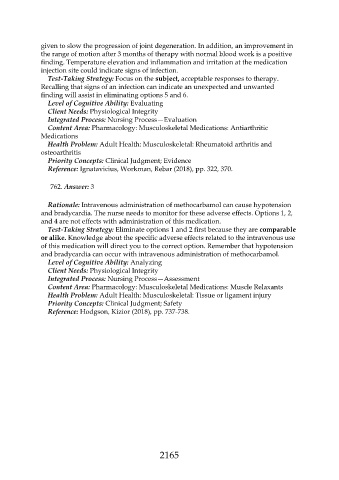Page 2165 - Saunders Comprehensive Review For NCLEX-RN
P. 2165
given to slow the progression of joint degeneration. In addition, an improvement in
the range of motion after 3 months of therapy with normal blood work is a positive
finding. Temperature elevation and inflammation and irritation at the medication
injection site could indicate signs of infection.
Test-Taking Strategy: Focus on the subject, acceptable responses to therapy.
Recalling that signs of an infection can indicate an unexpected and unwanted
finding will assist in eliminating options 5 and 6.
Level of Cognitive Ability: Evaluating
Client Needs: Physiological Integrity
Integrated Process: Nursing Process—Evaluation
Content Area: Pharmacology: Musculoskeletal Medications: Antiarthritic
Medications
Health Problem: Adult Health: Musculoskeletal: Rheumatoid arthritis and
osteoarthritis
Priority Concepts: Clinical Judgment; Evidence
Reference: Ignatavicius, Workman, Rebar (2018), pp. 322, 370.
762. Answer: 3
Rationale: Intravenous administration of methocarbamol can cause hypotension
and bradycardia. The nurse needs to monitor for these adverse effects. Options 1, 2,
and 4 are not effects with administration of this medication.
Test-Taking Strategy: Eliminate options 1 and 2 first because they are comparable
or alike. Knowledge about the specific adverse effects related to the intravenous use
of this medication will direct you to the correct option. Remember that hypotension
and bradycardia can occur with intravenous administration of methocarbamol.
Level of Cognitive Ability: Analyzing
Client Needs: Physiological Integrity
Integrated Process: Nursing Process—Assessment
Content Area: Pharmacology: Musculoskeletal Medications: Muscle Relaxants
Health Problem: Adult Health: Musculoskeletal: Tissue or ligament injury
Priority Concepts: Clinical Judgment; Safety
Reference: Hodgson, Kizior (2018), pp. 737-738.
2165

